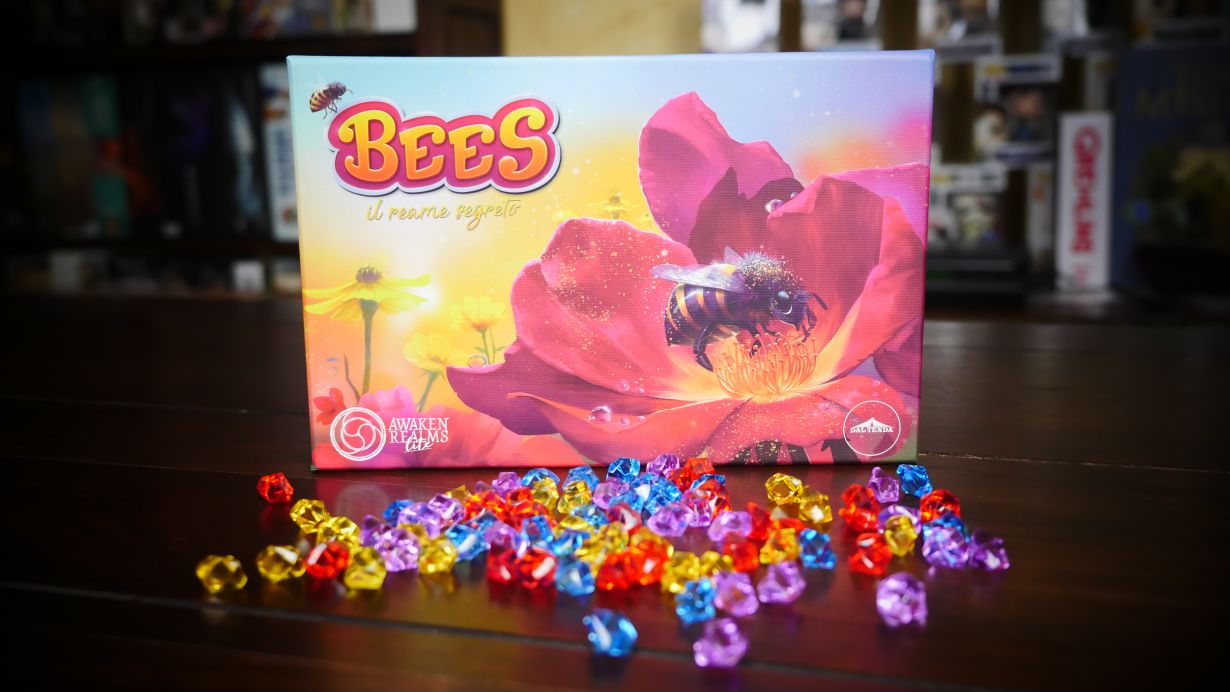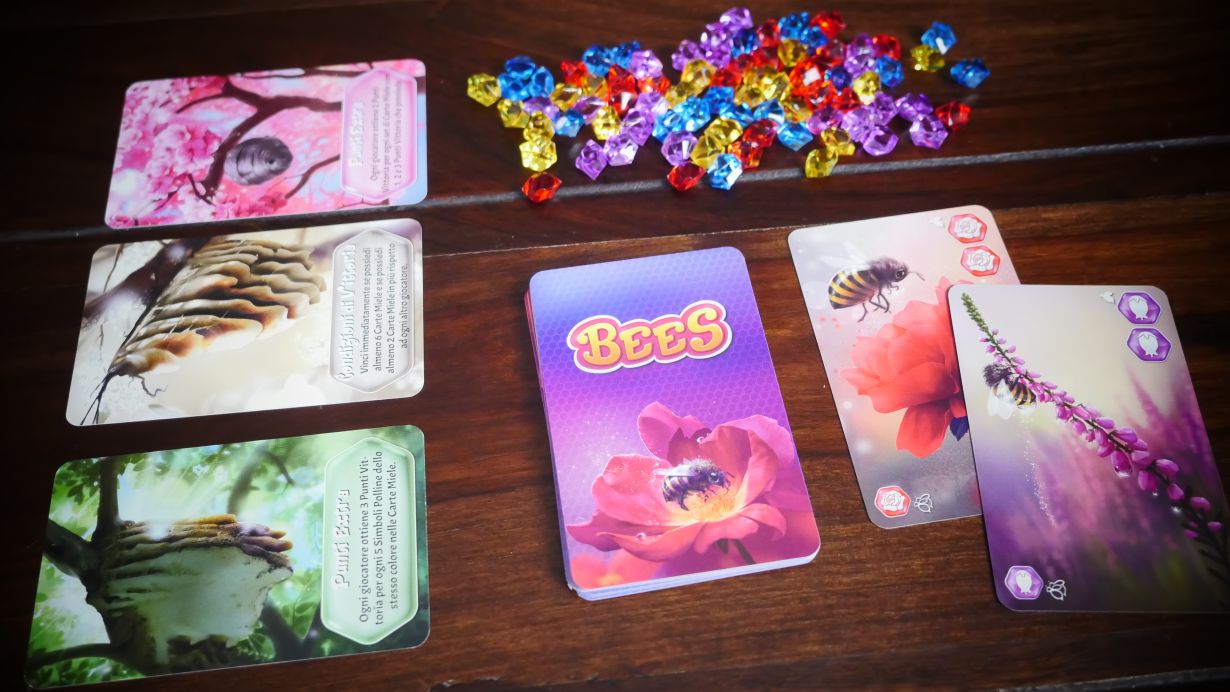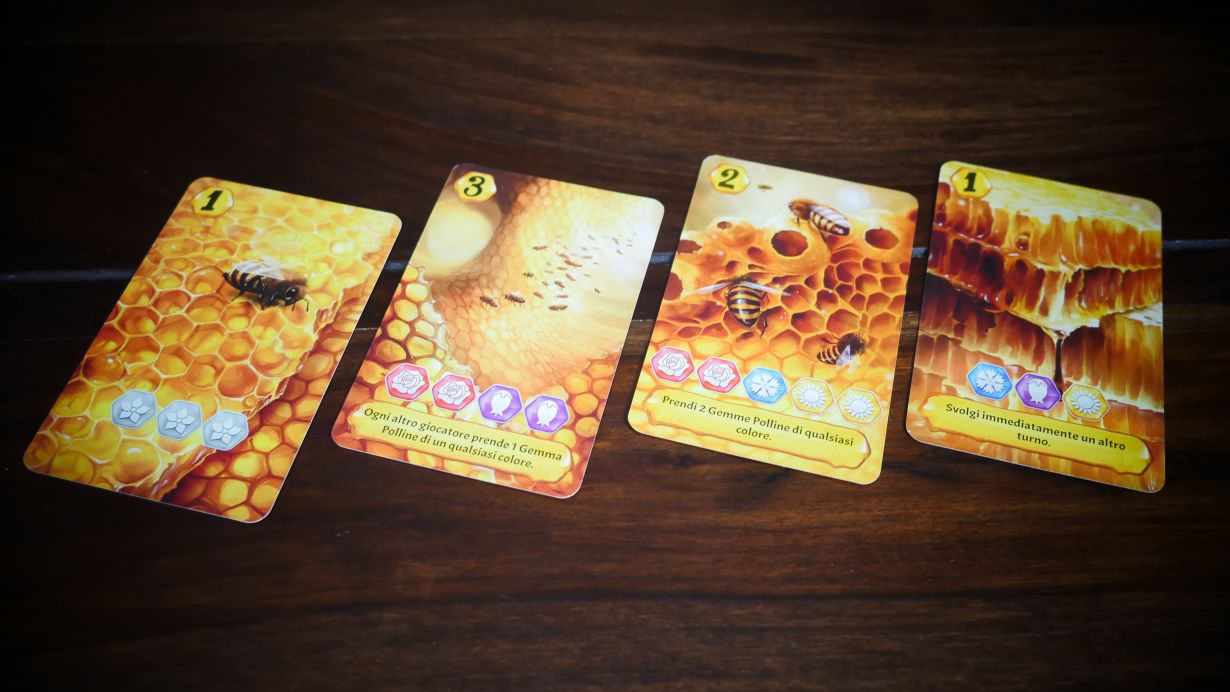

A quote often attributed (probably incorrectly) to Albert Einstein states that when bees go extinct on Earth, man will have only 4 years of life left. This very important animal is not only at the center of the biological balance of our planet, but also of the board game of which today we propose ours review: Bees: the Secret Realm. We are talking about a card game in which the aim is to go and collect many different types of honey, with simple mechanics, very immediate and especially suitable for very young players (both by age and in terms of experience).
Bees: the Secret Realm, the review of the board game
Bees is a board game of Kamil ‘Sanex’ Cieśla, originally published by Awaken Realms Quarrel, Awaken Realms’ entry level division of titles (Nemesis, Tainted Grail) has recently arrived in Italy (and in Italian) thanks to From the Tent (Saint Mary). It is a game for 2 to 6 players, playable in about 10 to 20 minutes, depending on the number of beekeepers at the table.
We are facing a game of collection of sets, or gems that represent pollen of various types. Pollen is used to purchase honey, or victory points. Bees contains two game modes, one simpler and one advanced; however, even with the advanced mode, the game remains very accessible to any player. We cannot fail to mention, even if only briefly, the aesthetic sector of the title: the work of the two artists Dagmara Gąska And Piotr Hornowski it is truly one of the most beautiful and elegant we have seen in recent times.
But the time has come to open the box and discover the nectar inside.
The contents of the Bees box
The box of Bees: the Secret Realm is compact in size, and easily transportable for playing on many occasions. Here’s what we find inside:
- 22 Collection Cards
- 48 Honey Cards
- 5 Hive Cards
- 80 Pollen buds
- The rules
The review of the components of the board game
Bees has a rather short list of components, but not of little value. The cards are large, fairly well made and above all richly illustrated by various and numerous drawings. The glance that they form at the game table is remarkable, aesthetically pleasing and light at the right point.
The gems are quite classic and similar to those seen in numerous other games. We appreciate that there are more than the actual maximum possible need. Being a title also intended for the youngest, having a few “spare parts” of the smaller components never hurts.
The quality of production of Bees: the Secret Realm is therefore quite good, with a reasonable and justified cost.
How to play Bees
First, the deck of Honey cards is formed, randomly taking 5 from the large offer for each player, and then another 5. 4 are revealed. Starting is the youngest player, who immediately takes a pollen gem freely; all the others, on the other hand, can choose 2 from the reserve.
If we want to use the advanced game mode, we also draw 3 Hive cards, and place them face up on the table. They award additional victory points according to certain requirements; they can add special victory conditions which, if satisfied, immediately end the game in favor of the player who satisfies them.
At this point the game begins, in which each player, in his turn, can take an action of his choice among the following:
- Collect pollen
- Obtain a Honey card
The first action takes place in this way: we draw two cards from the collected deck, choose one and obtain the amount of pollen indicated at the top right. Usually these are two gems, but there are some cards that work a little differently, which we will see later. Instead, all the other players get a gem indicated at the bottom left, but sometimes (depending on the card) they can choose between two colors. Once this is done, both cards are discarded and the turn passes to the next player.
The maximum amount of pollen buds we can have is 3 for each color.
The second action instead requires that you acquire a Honey card of your choice among the 4 uncovered. To do this, we must pay the cost by discarding pollen buds from our stock to the common one. Some Honey cards also contain an action, which the player is forced to resolve if he chooses to take them. The purchased Honey card is immediately replaced by another one taken from the deck, and the turn passes to the next player.
When a player buys a Honey card and this causes it to be replaced by the last one in the face-down Honey deck, the last game turn is triggered. All players, except the one who “caused” the end of the game, take one last turn. To determine the best beekeeper, the points of the Honey cards are counted, any points of the Hive cards to which a victory point is added for every 3 pollen gems left.
Conclusions of the Bees board game review
Having tasted the honey, let’s now move on to our conclusions of the Bees board game review.
We are faced with a very simple game, suitable for playing with novice or very young players; but this does not mean that it lacks a certain degree of strategy. The scores at the end of the game are not very high, and we often find ourselves in the end “fighting” for each point, weighing each decision. In this, the Hive cards count a lot, which can really make a big difference; our advice is to use them if the level of the players at the table allows it; indeed, it is a bit of a shame that there are not more of them. We have only 5 available, of which 3 are always used; a few more would have guaranteed a greater degree of replayability and a slightly different experience between games.
Some choices in the game design phase left us a bit perplexed, for example the assignment of initial resources based on the order in which the game begins. Unlike many other titles, in Bees whoever goes first is slightly at a disadvantage. This is due to the compensation mechanic that gets a gem on someone else’s turn. This means that, for example, the first player can only collect pollen (at least two gems are required to buy Honey cards), while the second and subsequent ones will be able to take a Honey card directly, if a little luck helps them.
The collection cards with 4 symbols have the particularity that all the players around the table receive 1 gem for each color. It is therefore difficult for them to be chosen: they would break the dynamic that means that in my turn the others obtain an advantage, but lower than mine. There may be cases in which it is convenient to choose these cards, but these are rare situations and a bit on the edge.
Some flaws – to tell the truth rather naive – however, do not ruin a game experience designed especially for those who approach our hobby for the first time. The splendid graphic sector, the feeling of being involved even during the turn of others and the immediacy of setup and explanation make Bees: the Secret Realm a title with a good degree of attractiveness to the public for which it is designed. There is some text on the cards, but if the older ones at the table make themselves available to read aloud, we see no problem proposing this title to preschool children as well.





